
Bivalvia, in previous centuries referred to as the Lamellibranchiata and Pelecypoda, is a class of marine and freshwater molluscs that have laterally compressed bodies enclosed by a shell consisting of two hinged parts. As a group, bivalves have no head and they lack some usual molluscan organs, like the radula and the odontophore. The class includes the clams, oysters, cockles, mussels, scallops, and numerous other families that live in saltwater, as well as a number of families that live in freshwater. The majority are filter feeders. The gills have evolved into ctenidia, specialised organs for feeding and breathing. Most bivalves bury themselves in sediment, where they are relatively safe from predation. Others lie on the sea floor or attach themselves to rocks or other hard surfaces. Some bivalves, such as the scallops and file shells, can swim. The shipworms bore into wood, clay, or stone and live inside these substances.
Phosphatic fossilization has occurred in unusual circumstances to preserve some extremely high-resolution microfossils in which careful preparation can even reveal preserved cellular structures. Such microscopic fossils are only visible under the scanning electron microscope.

A cockle is an edible marine bivalve mollusc. Although many small edible bivalves are loosely called cockles, true cockles are species in the family Cardiidae.

Tridacna crocea, the boring clam, crocus clam, crocea clam or saffron-coloured clam, is a species of bivalve in the family Cardiidae. It is native to the Indo-Pacific region. It is occasionally found in the aquarium trade where it is often simply referred to as crocea.

Cerastoderma is a genus of marine bivalves in the family Cardiidae. It includes the common cockle Cerastoderma edule.
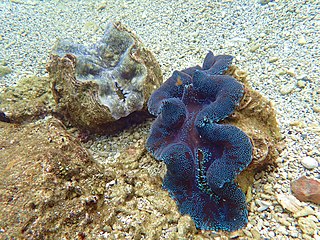
Tridacninae, common name the giant clams, is a taxonomic subfamily of very large saltwater clams, marine bivalve molluscs in the family Cardiidae, the cockles.
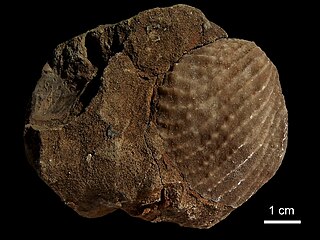
Myophorella is a genus of fossil saltwater clams, marine bivalve mollusks in the family Trigoniidae. These bivalves are sometimes preserved with mineralized soft tissue.
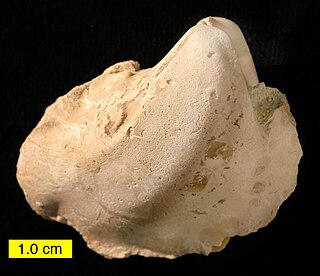
Laevitrigonia is a genus of fossil clams, marine bivalve mollusks in the family Trigoniidae. This bivalve is sometimes preserved with mineralized soft-tissue.
Americardia is a genus of saltwater clams, marine bivalve molluscs in the family Cardiidae, the cockles.

Clinocardium is a genus of marine bivalve molluscs in the family Cardiidae, the cockles. It is monotypic, being represented by the single species Clinocardium nuttallii, also known as the basket cockle or Nuttall's cockle, a large edible saltwater clam.

Corculum cardissa, the heart cockle, is a species of marine bivalve mollusc in the family Cardiidae. It is found in the Indo-Pacific region. It has a symbiotic relationship with dinoflagellates (zooxanthellae), which live within its tissues.
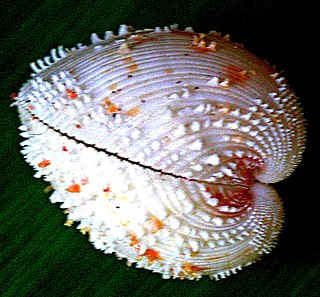
Fragum is a genus of cockles, marine bivalve molluscs in the family Cardiidae. Members of the genus have characteristic thick, sculptured shells and live buried in sand, extending their siphons to the surface to feed and breathe. They are found in the Indo-Pacific region and the Red Sea.

Cardioidea is a taxonomic superfamily of saltwater clams, marine bivalve molluscs consisting of the extant Cardiidae (cockles) and the extinct Pterocardiidae.
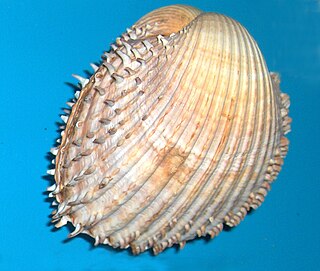
Acanthocardia is a genus of saltwater clams, marine bivalve molluscs in the family Cardiidae. Like most other bivalves, these mollusks are suspension feeders. This genus is present from the Upper Oligocene to the Recent.

Hinge teeth are part of the anatomical structure of the inner surface of a bivalve shell, i.e. the shell of a bivalve mollusk. Bivalves by definition have two valves, which are joined together by a strong and flexible ligament situated on the hinge line at the dorsal edge of the shell. In life, the shell needs to be able to open slightly to allow the foot and siphons to protrude, and then close again, without the valves moving out of alignment with one another. To make this possible, in most cases the two valves are articulated using an arrangement of structures known as hinge teeth. Like the ligament, the hinge teeth are also situated along the hinge line of the shell, in most cases.

Dinocardium is a genus of large saltwater clams or cockles, marine bivalve molluscs in the family Cardiidae, the cockles. There is only one species in the genus, Dinocardium robustum, or the Atlantic giant cockle.

Fragum erugatum is a small species of cockle, a marine bivalve mollusc in the family Cardiidae. It is found in the shallow seas off the coast of Western Australia. It is commonly known as the Hamelin cockle, cardiid cockle or heart cockle.

Lunulicardia is a genus of saltwater clams, marine bivalve molluscs in the family Cardiidae, the cockles. Fossils species in this genus are present in the Pliocene deposits of Indonesia and the Miocene deposits of Russia.

Pseudofulvia is a genus of saltwater clams, marine bivalve mollusks in the subfamily Laevicardiinae of the family Cardiidae, the cockles.














